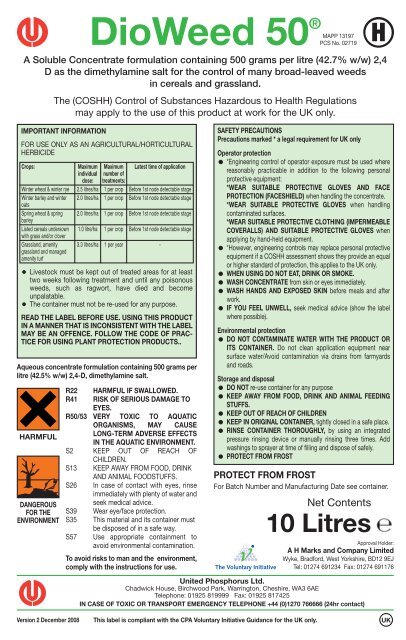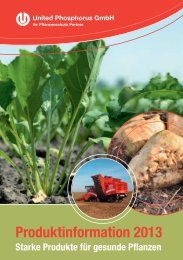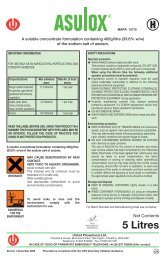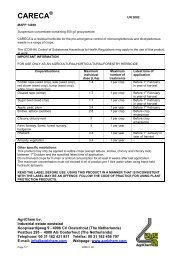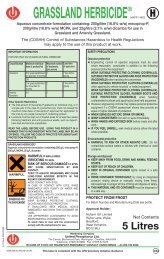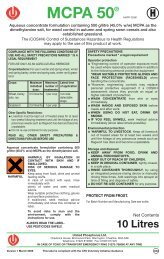DioWeed 50® - United Phosphorus Limited
DioWeed 50® - United Phosphorus Limited
DioWeed 50® - United Phosphorus Limited
Create successful ePaper yourself
Turn your PDF publications into a flip-book with our unique Google optimized e-Paper software.
<strong>DioWeed</strong> 50 ®<br />
H<br />
A Soluble Concentrate formulation containing 500 grams per litre (42.7% w/w) 2,4<br />
D as the dimethylamine salt for the control of many broad-leaved weeds<br />
in cereals and grassland.<br />
The (COSHH) Control of Substances Hazardous to Health Regulations<br />
may apply to the use of this product at work for the UK only.<br />
IMPORTANT INFORMATION<br />
FOR USE ONLY AS AN AGRICULTURAL/HORTICULTURAL<br />
HERBICIDE<br />
Crops:<br />
Winter wheat & winter rye<br />
Winter barley and winter<br />
oats<br />
Spring wheat & spring<br />
barley<br />
Listed cereals undersown<br />
with grass and/or clover<br />
Grassland, amenity<br />
grassland and managed<br />
amenity turf<br />
Livestock must be kept out of treated areas for at least<br />
two weeks following treatment and until any poisonous<br />
weeds, such as ragwort, have died and become<br />
unpalatable.<br />
The container must not be re-used for any purpose.<br />
READ THE LABEL BEFORE USE. USING THIS PRODUCT<br />
IN A MANNER THAT IS INCONSISTENT WITH THE LABEL<br />
MAY BE AN OFFENCE. FOLLOW THE CODE OF PRAC-<br />
TICE FOR USING PLANT PROTECTION PRODUCTS..<br />
Aqueous concentrate formulation containing 500 grams per<br />
litre (42.5% w/w) 2,4-D, dimethylamine salt.<br />
HARMFUL<br />
DANGEROUS<br />
FOR THE<br />
ENVIRONMENT<br />
Maximum<br />
individual<br />
dose:<br />
2.5 litres/ha<br />
2.0 litres/ha<br />
2.0 litres/ha<br />
1.0 litre/ha<br />
3.3 litres/ha<br />
Maximum<br />
number of<br />
treatments:<br />
1 per crop<br />
1 per crop<br />
1 per crop<br />
1 per crop<br />
1 per year<br />
Latest time of application<br />
Before 1st node detectable stage<br />
Before 1st node detectable stage<br />
Before 1st node detectable stage<br />
Before 1st node detectable stage<br />
R22 HARMFUL IF SWALLOWED.<br />
R41 RISK OF SERIOUS DAMAGE TO<br />
EYES.<br />
R50/53 VERY TOXIC TO AQUATIC<br />
ORGANISMS, MAY CAUSE<br />
LONG-TERM ADVERSE EFFECTS<br />
IN THE AQUATIC ENVIRONMENT.<br />
S2 KEEP OUT OF REACH OF<br />
CHILDREN.<br />
S13 KEEP AWAY FROM FOOD, DRINK<br />
AND ANIMAL FOODSTUFFS.<br />
S26 In case of contact with eyes, rinse<br />
immediately with plenty of water and<br />
seek medical advice.<br />
S39 Wear eye/face protection.<br />
S35 This material and its container must<br />
be disposed of in a safe way.<br />
S57 Use appropriate containment to<br />
avoid environmental contamination.<br />
To avoid risks to man and the environment,<br />
comply with the instructions for use.<br />
-<br />
MAPP 13197<br />
PCS No. 02719<br />
SAFETY PRECAUTIONS<br />
Precautions marked * a legal requirement for UK only<br />
Operator protection<br />
*Engineering control of operator exposure must be used where<br />
reasonably practicable in addition to the following personal<br />
protective equipment:<br />
*WEAR SUITABLE PROTECTIVE GLOVES AND FACE<br />
PROTECTION (FACESHIELD) when handling the concentrate.<br />
*WEAR SUITABLE PROTECTIVE GLOVES when handling<br />
contaminated surfaces.<br />
*WEAR SUITABLE PROTECTIVE CLOTHING (IMPERMEABLE<br />
COVERALLS) AND SUITABLE PROTECTIVE GLOVES when<br />
applying by hand-held equipment.<br />
*However, engineering controls may replace personal protective<br />
equipment if a COSHH assessment shows they provide an equal<br />
or higher standard of protection, this applies to the UK only.<br />
WHEN USING DO NOT EAT, DRINK OR SMOKE.<br />
WASH CONCENTRATE from skin or eyes immediately.<br />
WASH HANDS AND EXPOSED SKIN before meals and after<br />
work.<br />
IF YOU FEEL UNWELL, seek medical advice (show the label<br />
where possible).<br />
Environmental protection<br />
DO NOT CONTAMINATE WATER WITH THE PRODUCT OR<br />
ITS CONTAINER. Do not clean application equipment near<br />
surface water/Avoid contamination via drains from farmyards<br />
and roads.<br />
Storage and disposal<br />
DO NOT re-use container for any purpose<br />
KEEP AWAY FROM FOOD, DRINK AND ANIMAL FEEDING<br />
STUFFS.<br />
KEEP OUT OF REACH OF CHILDREN<br />
KEEP IN ORIGINAL CONTAINER, tightly closed in a safe place.<br />
RINSE CONTAINER THOROUGHLY, by using an integrated<br />
pressure rinsing device or manually rinsing three times. Add<br />
washings to sprayer at time of filling and dispose of safely.<br />
PROTECT FROM FROST<br />
PROTECT FROM FROST<br />
For Batch Number and Manufacturing Date see container.<br />
Net Contents<br />
10 Litres<br />
Approval Holder:<br />
A H Marks and Company <strong>Limited</strong><br />
Wyke, Bradford, West Yorkshire, BD12 9EJ<br />
Tel: 01274 691234 Fax: 01274 691176<br />
<strong>United</strong> <strong>Phosphorus</strong> Ltd.<br />
Chadwick House, Birchwood Park, Warrington, Cheshire, WA3 6AE<br />
Telephone: 01925 819999 Fax: 01925 817425<br />
IN CASE OF TOXIC OR TRANSPORT EMERGENCY TELEPHONE +44 (0)1270 766666 (24hr contact)<br />
Version 2 December 2008 This label is compliant with the CPA Voluntary Initiative Guidance for the UK only.<br />
UK
DIRECTIONS FOR USE<br />
IMPORTANT: This information is approved as part of the product label. All instructions within this section must be read carefully in order to obtain<br />
safe and successful use of this product.<br />
RESTRICTIONS/WARNINGS<br />
DIOWEED 50 is active at low concentrations. DO NOT spray in windy conditions as the spray drift may cause damage to neighbouring<br />
crops. The following crops are particularly susceptible: Beet, Brassicae (e.g. turnips, swedes, oilseed rape) onions, and most market<br />
garden crops including lettuce, cucumber and tomatoes under glass, pears and vines.<br />
Wash equipment thoroughly with water and wetting agent or liquid detergent immediately after use. Spray out, fill with clean water and<br />
leave overnight. Spray out again before storing or using for another product. Traces of product can cause harm to susceptible crops<br />
sprayed later.<br />
DO NOT apply during rain or if rain is expected.<br />
DO NOT roll or harrow crops within seven days before or after applying DIOWEED 50.<br />
DO NOT apply immediately before or after sowing any crop.<br />
DO NOT plant succeeding crops within 3 months of applying DIOWEED 50.<br />
DO NOT mow or roll turf or amenity grassland for four days before or after application. The first four mowings after treatment must be<br />
composted for at least 6 months before use.<br />
DO NOT treat cereals, grass or turf suffering from stress caused by drought, disease or other adverse factors, such as freezing conditions.<br />
Agricultural grassland destined for hay or silage in the spring, should be sprayed in the preceding autumn.<br />
Dioweed 50 may be applied to grassland or turf that has been established for a minimum of 12 months.<br />
WEEDS CONTROLLED<br />
WEED SUSCEPTIBILITY TABLE - CEREALS<br />
Weeds<br />
Black Mustard (Brassica nigra),<br />
Charlock (Sinapis arvensis)<br />
Fat-Hen (Chenopodium album)<br />
Field Pennycress (Thlaspi arvense)<br />
Hairy Tare (Vicia hirsute)<br />
Treacle Mustard (Erysimum cheiranthoides)<br />
White Mustard (Sinapis alba)<br />
Shepherds Purse (Capsella bursa-pastoris)<br />
Small Nettle (Urtica urens)<br />
Wild Radish (Raphanus raphanistrum)<br />
Corn Buttercup (Ranunculus arvensis)<br />
Common Orache (Atriplex patula)<br />
Common Poppy (Papaver rhoeas)<br />
Field Forget-me-not (Myosotis arvensis)<br />
Prickly Sowthistle (Sonchus asper)<br />
Smooth Sowthistle (Sonchus oleraceus)<br />
Wild Turnip (Brassica rapa)<br />
Black-bindweed (Polygonum convolvulus)<br />
Black nightshade (Solanum nigrum)<br />
Bugloss (Lycopsis arvensis)<br />
Common Chickweed (Stellaria media)<br />
Common field-speedwell (Veronica persica)<br />
Common fumitory (Fumaria officinalis)<br />
Common Mouse-ear (Cerastium holosteoides)<br />
Dove’s-foot Crane’s-bill (Geranium molle)<br />
Field Gromwell (Lithospermum arvense)<br />
Green Field speedwell (Veronica agrestis)<br />
Groundsel (Senecio vulgaris),<br />
Ivy-leaved Speedwell (Veronica hederifolia)<br />
Knotgrass (Polygonum aviculare)<br />
Pale Persicaria (Polygonum lapathifolium)<br />
Redshank (Polygonum persicaria)<br />
Scarlet Pimpernel (Anagallis arvensis)<br />
Shepherd’s-needle (Scandix pectin-veneris)<br />
Sun spurge (Euphorbia helioscopia)<br />
Viper’s-bugloss (Echium vulgare)<br />
Wall speedwell (Veronica arvensis)<br />
Common Orache (Atriplex patula)<br />
Common Poppy (Papaver rhoeas)<br />
Smooth Sowthistle (Sonchus oleraceus)<br />
Knotgrass (Polygonum aviculare)<br />
Scentless Mayweed (Tripleurospermum maritimum)<br />
Creeping Thistle† (Cirsium arvense)<br />
Rate/ha<br />
0.7 L<br />
S = Susceptible MS = Moderately Susceptible MR = Moderately Resistant R = Resistant † = aerial growth only<br />
1.4 L<br />
1.4 L<br />
1.4 L<br />
1.4 L<br />
1.4 L<br />
2.0 L<br />
2.0 L<br />
2.0-2.5 L<br />
Level of control<br />
S (Cotyledon to Early flower-bud)<br />
S (Cotyledon to Early flower-bud)<br />
S (Cotyledon to 8 expanded true leaves)<br />
S (Cotyledon to 2 expanded true leaves)<br />
MR (4 expanded true leaves to early flower-bud)<br />
MS (Cotyledon-2 expanded true leaves)<br />
MR (4 expanded true leaves to early flower-bud)<br />
MR (Cotyledon to 2 expanded true leaves)<br />
R (4 expanded true leaves -early flower-bud)<br />
S (Cotyledon-4 expanded true leaves)<br />
MR (6 expanded true leaves to early flower-bud)<br />
MR (Cotyledon-2 expanded true leaves)<br />
R (4 expanded true leaves to early flower-bud)<br />
S (Cotyledon to early flower-bud)
WEED SUSCEPTIBILITY TABLE – GRASSLAND (Non-amenity uses)<br />
Weeds<br />
Autumn hawkbit (Leontodon autumnalis),<br />
Creeping buttercup (Ranunculus repens) [1] ,<br />
Plantains (Plantago spp.)<br />
Cat’s ear (Hypochaeris radicata),<br />
Common knapweed (Centaurea nigra),<br />
Common nettle (Urtica diocia),<br />
Creeping thistle (Cirsium arvense) [2] ,<br />
Curled dock (Rumex crispus) [4] ,<br />
Daisy (Bellis perennis),<br />
Dandelion (Taraxacum officinale),<br />
Meadow buttercup (Ranunculus acris) [1] ,<br />
Self-heal (Prunella vulgaris),<br />
Spear thistle (Cirsium vulgare),<br />
Soft rush (Juncus effusus) [5]<br />
Common ragwort (Senecio jacobaea) [6]<br />
Broad-leaved dock (Rumex obtusifolius) [4] ,<br />
Bulbous buttercup (Ranunculus bulbosus) [3] ,<br />
Common ragwort (Senecio jacobaea) [8] ,<br />
Common sorrel (Rumex acetosa) [4] ,<br />
Dwarf thistle (Cirsium acaule),<br />
Hard rush (Juncus inflexus),<br />
Horsetails (Equisetum spp.) [7] ,<br />
Meadowsweet (Filipendula ulmaria),<br />
Perennial sow-thistle (Sonchus arvensis),<br />
Sheep’s sorrel (Rumex acetosella) [4] ,<br />
Wild onion (Allium vineale),<br />
Yarrow (Achillea millefolium),<br />
Yellow rattle (Rhinanthus minor)<br />
Rate/ha<br />
2.8 L<br />
2.8 L<br />
3.3 L<br />
2.8 L<br />
Notes:<br />
[1] Treat in spring or early summer<br />
[2] Treat at early flower bud stage<br />
[3] Treat in the autumn on new leaf or in the spring<br />
[4] Treat either pre-flowering in May or any time after defoliation, when growing vigorously (use 1.6 l/ha on seedling Dock spp.)<br />
[5] Treat before flowering and cut 4 weeks after (or before) treatment to improve control.<br />
[6] Treatment will normally kill plants at all stages of growth up to the early bud stage. For best levels of control, treat in April to June when<br />
rosettes are growing strongly but before flower buds are well formed.<br />
[7] Treat when growing well in May or early June. Top growth is removed or considerably reduced for the season of treatment.<br />
In grassland for hay or silage, shoot kill may be obtained by using 2.0 l/ha two weeks before cutting.<br />
[8] Treat before flowering when the flowering shoot is developing rapidly and seedlings & rosettes are growing strongly.<br />
WEED SUSCEPTIBILITY TABLE - AMENITY GRASSLAND & MANAGED AMENITY TURF<br />
Weeds<br />
Creeping buttercup (Ranunculus repens)<br />
Mouse-ear hawkweed (Hieracium pilosella)<br />
Plantains (Plantago sp.)<br />
Thrift (Armeria maritima).<br />
Bulbous buttercup (Ranunculus bulbosus)<br />
Cats-ear (Hypochaeris radicata)<br />
Common chickweed (Stellaria media)<br />
Common ragwort (Senecio jacobaea)<br />
Common sorrel (Rumex acetosa)<br />
Curled dock (Rumex crispus)<br />
Daisy (Bellis perennis)<br />
Dandelion (Taraxacum officinale)<br />
Dwarf thistle (Cirsium acaule)<br />
Hawkbits (Leontodon sp.)<br />
Heath bedstraw (Galium saxatile)<br />
Marsh pennywort (Hydrocotyle vulgaris)<br />
Sea-milkwort (Glaux maritima)<br />
Sheep’s sorrel (Rumex acetosella)<br />
Smooth hawk’s-beard (Crepis capillaris)<br />
Stork’s-bills (Erodium sp.).<br />
Rate/ha<br />
2.8 L<br />
2.8 L<br />
Comments<br />
Susceptible<br />
(Consistently good control, both shoots and roots)<br />
Moderately Susceptible<br />
(Aerial growth usually killed and a useful measure of<br />
long-term control obtained under suitable conditions)<br />
Moderately Susceptible<br />
(Aerial growth usually killed and a useful measure of<br />
long-term control obtained under suitable conditions)<br />
Moderately Resistant<br />
(Variable effect on aerial growth; appreciable long-term control<br />
unlikely)<br />
Comments<br />
Susceptible<br />
(Consistently killed by one application)<br />
Moderately Susceptible<br />
(Sometimes killed by one application, but may require a further<br />
application of an alternative product to give complete<br />
control.)
Common mouse-ear (Cerastium holosteoides)<br />
Creeping cinquefoil (Potentilla reptans)<br />
Lesser celandine (Ranunculus ficaria)<br />
Procumbent pearlwort (Sagina procumbens)<br />
Selfheal (Prunella vulgaris)<br />
Silverweed (Potentilla anserina)<br />
Yarrow (Achillea millefolium).<br />
TREATMENT OF CROPS<br />
Spray weeds when the crop is actively growing. In general, annual weeds are more susceptible at the seedling stage and perennials when the<br />
flower bud is forming. Timing of cereal spray must be determined by the crop growth stage.<br />
Cereals<br />
Apply DIOWEED 50 in 100-1000 litres of water per hectare using any standard high or low volume sprayer. Recommended rates are given in<br />
the weed susceptibility table for cereals. It is important not to exceed the maximum safe dose as follows:<br />
Crop<br />
Winter Cereals:<br />
Wheat or Rye<br />
Barley or Oats<br />
Spring Cereals:<br />
Wheat or barley<br />
Oats<br />
Maximum Dose<br />
2.5 litres/ha<br />
2.0 litres/ha<br />
2.0 litres/ha<br />
Not recommended<br />
Undersown Cereals<br />
For cereals undersown with grass and/or clover but not lucerne. DO NOT spray with DIOWEED 50 before undersowing. Experience has shown<br />
that when weeds and cereals form a canopy, undersown crops may be safely treated using not more than 1.0 litre/ha at low volume. Clovers<br />
should have developed two to three true leaves before spraying. Red Clovers may be damaged.<br />
Grassland<br />
Spray perennial weeds during their period of maximum growth, usually when the flower buds are beginning to form. The responses of perennial<br />
weeds to treatments are variable often only the aerial parts are killed but suppression may also occur. The recovery of weeds will be reduced<br />
if the crop is growing vigorously at the time of treatment.<br />
Grassland (non-amenity uses)<br />
Do not treat where clovers or other legumes are an important part of the sward. Grassland may be treated with 2.8 3.3 litres/ha of DIOWEED<br />
50 according to the weeds present. Recommended rates are given in the weed susceptibility table for grassland. Clovers will receive a check.<br />
Top dressing ten days before treatment is recommended to assist kill of weeds and subsequent recovery of the sward.<br />
Amenity Grassland and Managed Amenity Turf<br />
Amenity grassland and managed amenity turf may be treated with 3.3 litres/ha of DIOWEED 50. The expected levels of control are detailed in<br />
the weed susceptibility table for amenity uses. Clovers will receive a check. Top dressing ten days before treatment is recommended to assist<br />
kill of weeds and subsequent recovery of the sward.<br />
TIME OF APPLICATION<br />
Spray weeds when the crop is actively growing. In general annual weeds are more susceptible at the seedling stage and perennials when the<br />
flower bud is forming. Timing of cereal spray must be determined by the stage of the crop growth.<br />
Winter cereals<br />
Spray in the spring from the leaf sheaf erect stage but before the first node detectable stage.<br />
Spring cereals<br />
Spray from the five-leaf fully expanded stage but before the first node detectable stage.<br />
2.8 L Moderately Resistant<br />
(Some effect from one application, but often requires two or<br />
three further applications of alternative products to give adequate<br />
control)<br />
Timing<br />
Spray in the spring from the leaf sheaf erect stage but before<br />
the first node detectible stage<br />
Spray from the five-leaf fully expanded stage but before the<br />
first node detectible stage.<br />
Grassland, Amenity Grassland and Managed Amenity Turf<br />
Spray perennial weeds during their period of maximum growth, usually when the flower buds are beginning to form. The responses of perennial<br />
weeds to treatments are variable often only the aerial parts are killed but suppression may also occur. The recovery of weeds will be reduced<br />
if the crop is growing vigorously at the time of treatment.<br />
OTHER INFORMATION<br />
When herbicides with the same mode of action are used repeatedly over several years in the same field, selection of resistant biotypes can<br />
take place. These can propagate and may become dominating. A weed species is considered to be resistant to a herbicide if it survives a correctly<br />
applied treatment at the recommended dose. A strategy for preventing and managing such resistance should be adopted. This should<br />
include integrating herbicides with a programme of cultural control measures. For the UK only, guidelines have been produced by the Weed<br />
Resistance Action Group and copies are available from the HGCA, CPA, your distributor, crop adviser or product manufacturer.<br />
CONDITIONS OF SUPPLY<br />
All goods supplied by us are of high grade and we believe them to be suitable but, as we cannot exercise control over their storage, handling, mixing or<br />
use, or the weather conditions before, during and after application which may affect the performance of the goods, all conditions and warranties, statutory<br />
or otherwise, as to the quality or fitness for any purpose of our goods are excluded, and no responsibility will be accepted by us or re-sellers for any<br />
failure in performance, damage or injury whatsoever arising from their storage, handling, application or use. Our staff or agents cannot vary these conditions<br />
whether or not they supervise or assist in the use of such goods.<br />
DIOWEED 50 is a trademark of <strong>United</strong> <strong>Phosphorus</strong> <strong>Limited</strong>. Other brand names used in this guide are trademarks of other manufacturers for which<br />
propriety rights may exist.


